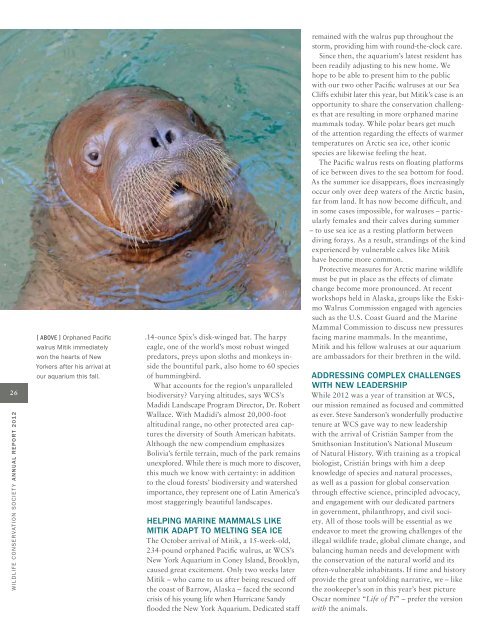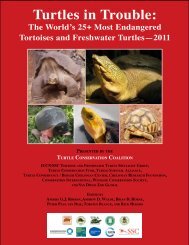WCS Annual Report 2012 - Wildlife Conservation Society
WCS Annual Report 2012 - Wildlife Conservation Society
WCS Annual Report 2012 - Wildlife Conservation Society
Create successful ePaper yourself
Turn your PDF publications into a flip-book with our unique Google optimized e-Paper software.
26<br />
wildlife conservation society <strong>Annual</strong> <strong>Report</strong> <strong>2012</strong><br />
[ above ] Orphaned Pacific<br />
walrus Mitik immediately<br />
won the hearts of New<br />
Yorkers after his arrival at<br />
our aquarium this fall.<br />
.14-ounce Spix’s disk-winged bat. The harpy<br />
eagle, one of the world’s most robust winged<br />
predators, preys upon sloths and monkeys inside<br />
the bountiful park, also home to 60 species<br />
of hummingbird.<br />
What accounts for the region’s unparalleled<br />
biodiversity? Varying altitudes, says <strong>WCS</strong>’s<br />
Madidi Landscape Program Director, Dr. Robert<br />
Wallace. With Madidi’s almost 20,000-foot<br />
altitudinal range, no other protected area captures<br />
the diversity of South American habitats.<br />
Although the new compendium emphasizes<br />
Bolivia’s fertile terrain, much of the park remains<br />
unexplored. While there is much more to discover,<br />
this much we know with certainty: in addition<br />
to the cloud forests’ biodiversity and watershed<br />
importance, they represent one of Latin America’s<br />
most staggeringly beautiful landscapes.<br />
Helping Marine Mammals Like<br />
Mitik Adapt to Melting Sea Ice<br />
The October arrival of Mitik, a 15-week-old,<br />
234-pound orphaned Pacific walrus, at <strong>WCS</strong>’s<br />
New York Aquarium in Coney Island, Brooklyn,<br />
caused great excitement. Only two weeks later<br />
Mitik – who came to us after being rescued off<br />
the coast of Barrow, Alaska – faced the second<br />
crisis of his young life when Hurricane Sandy<br />
flooded the New York Aquarium. Dedicated staff<br />
remained with the walrus pup throughout the<br />
storm, providing him with round-the-clock care.<br />
Since then, the aquarium’s latest resident has<br />
been readily adjusting to his new home. We<br />
hope to be able to present him to the public<br />
with our two other Pacific walruses at our Sea<br />
Cliffs exhibit later this year, but Mitik’s case is an<br />
opportunity to share the conservation challenges<br />
that are resulting in more orphaned marine<br />
mammals today. While polar bears get much<br />
of the attention regarding the effects of warmer<br />
temperatures on Arctic sea ice, other iconic<br />
species are likewise feeling the heat.<br />
The Pacific walrus rests on floating platforms<br />
of ice between dives to the sea bottom for food.<br />
As the summer ice disappears, floes increasingly<br />
occur only over deep waters of the Arctic basin,<br />
far from land. It has now become difficult, and<br />
in some cases impossible, for walruses – particularly<br />
females and their calves during summer<br />
– to use sea ice as a resting platform between<br />
diving forays. As a result, strandings of the kind<br />
experienced by vulnerable calves like Mitik<br />
have become more common.<br />
Protective measures for Arctic marine wildlife<br />
must be put in place as the effects of climate<br />
change become more pronounced. At recent<br />
workshops held in Alaska, groups like the Eskimo<br />
Walrus Commission engaged with agencies<br />
such as the U.S. Coast Guard and the Marine<br />
Mammal Commission to discuss new pressures<br />
facing marine mammals. In the meantime,<br />
Mitik and his fellow walruses at our aquarium<br />
are ambassadors for their brethren in the wild.<br />
addressing Complex challenges<br />
with new leadership<br />
While <strong>2012</strong> was a year of transition at <strong>WCS</strong>,<br />
our mission remained as focused and committed<br />
as ever. Steve Sanderson’s wonderfully productive<br />
tenure at <strong>WCS</strong> gave way to new leadership<br />
with the arrival of Cristián Samper from the<br />
Smithsonian Institution’s National Museum<br />
of Natural History. With training as a tropical<br />
biologist, Cristián brings with him a deep<br />
knowledge of species and natural processes,<br />
as well as a passion for global conservation<br />
through effective science, principled advocacy,<br />
and engagement with our dedicated partners<br />
in government, philanthropy, and civil society.<br />
All of those tools will be essential as we<br />
endeavor to meet the growing challenges of the<br />
illegal wildlife trade, global climate change, and<br />
balancing human needs and development with<br />
the conservation of the natural world and its<br />
often-vulnerable inhabitants. If time and history<br />
provide the great unfolding narrative, we – like<br />
the zookeeper’s son in this year’s best picture<br />
Oscar nominee “Life of Pi” – prefer the version<br />
with the animals.







![RaLand / SeaScape [PDF] - Wildlife Conservation Society](https://img.yumpu.com/49974326/1/190x245/raland-seascape-pdf-wildlife-conservation-society.jpg?quality=85)









